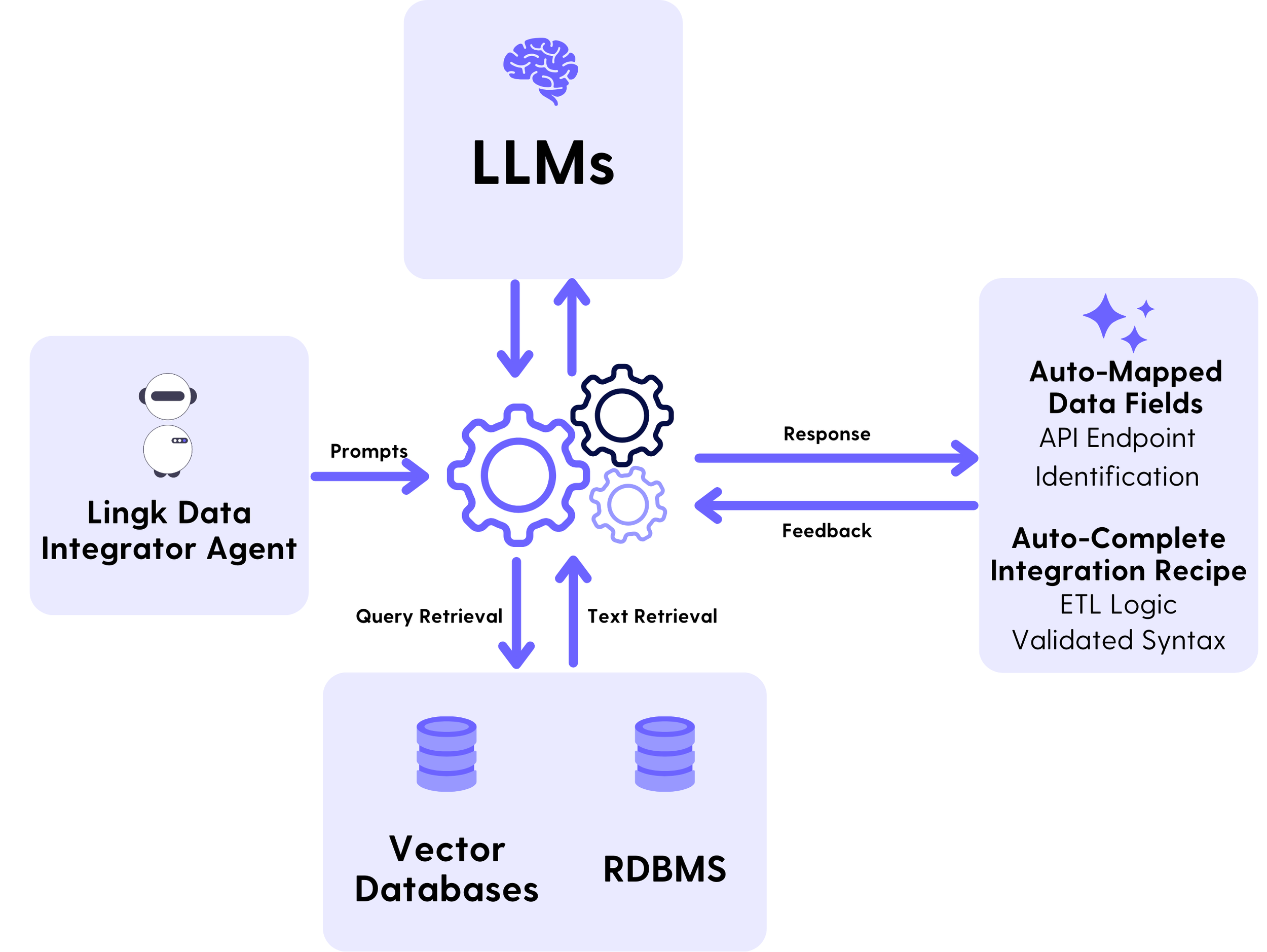Implementing RAG Architecture for Enterprise System Integration Workflows
How Lingk’s Agents Use Retrieval-Augmented Generation for Faster, Smarter Integrations.
Published Nov 19, 2024
Advancements in artificial intelligence and machine learning, particularly in Retrieval-Augmented Generation (RAG), are transforming the integration landscape. By harnessing RAG architecture, Lingk’s Data Agents leverage Large Language Models (LLMs) with contextualized data that enable smarter results and more efficient integrations—reducing project delivery times and saving on resources.
What is Retrieval-Augmented Generation (RAG)?
Retrieval-Augmented Generation (RAG) is a powerful AI architecture that combines retrieval mechanisms with generative capabilities. At its core, RAG involves two key components:
Retrieval: This involves querying a database or knowledge base (vector database) to find the most relevant data or documents based on the input query. Using advanced semantic search techniques, RAG can identify the information that aligns with the query’s intent, even if the prompts don’t match exactly.
Generation: Once the most relevant information is retrieved, a large language model—such as GPT-4o, Claude 3.5 Sonnet or Gemini 1.5 Pro—uses that data to generate a response, complete a task, or make predictions. The retrieval stage effectively “augments” the LLM, allowing it to generate more contextually accurate and relevant outputs.
RAG has become a popular tool in areas like customer support, content generation, and sales—but its potential extends far beyond these applications. In the realm of data integration, RAG can enable more efficient mapping, transformation, and validation processes, minimizing the burden on IT teams and accelerating project timelines.
How Lingk Uses RAG for Intelligent System Integrations
Lingk’s platform leverages RAG architecture within its family of Autonomous Data Agents to power efficient, AI-driven data integration. Our Data Integrator Agent, built on RAG principles, significantly accelerates the integration process by automating data mapping, generating ETL recipes, and validating workflows. Here’s how it works:
Data Mapping with Semantic Search: Lingk’s Data Integrator Agent uses a vector database of metadata, schema definitions, and field mappings from a wide range of enterprise systems. By performing a semantic search, the agent identifies source and destination fields that match in meaning—even if field names vary—allowing for accurate and rapid data alignment. This search capability drastically reduces the time needed to manually identify appropriate mappings.
ETL Recipe Development with Contextual Data Generation: The Data Integrator Agent taps into a database of best practices and sample ETL logic to retrieve relevant transformation steps. The agent then uses a language model to tailor these steps to the specific integration at hand, creating an ETL recipe that is ready for deployment. By automatically generating ETL logic, Lingk reduces integration delivery times by up to 50%.
Real-Time Validation and Feedback: Lingk’s AI agents also validate schema compatibility, syntax, and API endpoint requirements in real-time, providing feedback on the fly. This ensures that integrations are not only fast but also error-free, improving the quality of the final implementation. IT teams no longer have to spend hours troubleshooting syntax errors or data mismatches.
With Lingk’s Data Integrator Agent, organizations can accelerate project timelines and reduce operational costs, enabling them to realize the benefits of SaaS applications and other integrations faster.
Enterprise Benefits of RAG Integration Workflows
Using RAG architecture for system integration offers several key advantages, especially in the context of complex, multi-system workflows. Here’s why RAG-powered agents like Lingk’s Data Integrator are a game-changer:
Speed: RAG accelerates data integration workflows by automating data mapping, ETL logic creation, and validation. Organizations can achieve project delivery timelines that are up to two-thirds shorter than traditional methods.
Cost Efficiency: By reducing the need for extensive manual configuration, RAG-powered agents save organizations more than 40% on integration project costs.
Improved Data Accuracy: Semantic search and real-time validation ensure that data mappings and transformations are accurate, reducing the risk of errors that can lead to compliance issues or operational disruptions.
Scalability: With RAG, integration workflows can be scaled across multiple systems and data sources, making it an ideal solution for growing enterprises with evolving data needs.
Lingk empowers organizations to realize the full potential of their digital ecosystems faster than ever before.
Whether your organization is navigating a complex SaaS implementation or designing a unified data architecture, Lingk’s autonomous AI agents and RAG-based approach can help improve data quality, and achieve your IT integration initiatives faster and at half the cost.
Discover the future of integrations with Lingk’s intelligent platform—built for modern, agile data workflows.
About Lingk
Lingk is an AI-first company committed to revolutionizing data integration and management in education. Our award-winning Integration Platform as a Service (iPaaS) and AI-powered Data Agents automate complex data workflows, enabling institutions to deliver projects faster, reduce operational costs, and scale effortlessly. With a focus on empowering educational institutions, Lingk helps unlock the full potential of data to drive innovation and success.
Follow us on LinkedIn.


